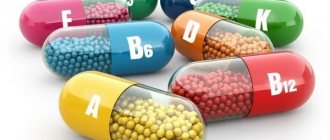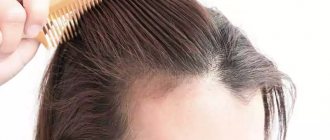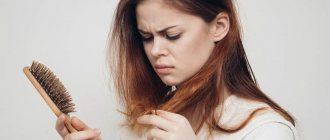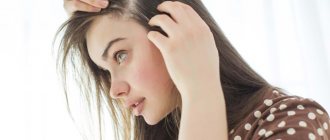For most men, with age, the hair follicles become weaker, the hair becomes thinner, and active hair loss begins. But sometimes we are not talking about age-related or genetic changes, but about pathology, when hair loss is associated with the condition of systems and organs. Hair loss, the appearance of bald spots of different diameters throughout the entire scalp (so-called pattern baldness in men) is a signal that it is necessary to conduct a comprehensive examination and find out the cause.
The result of alopecia areata can be complete baldness. If such a phenomenon is detected, the first step is to contact a trichologist. It will help determine the exact cause of alopecia. Treatment begins with eliminating the primary sources that led to the pathology. Only after this will it be possible to take care of the condition of your hair.
Stress
Stress negatively affects overall well-being, provokes exacerbation of chronic diseases, and causes alopecia. Stress causes hair loss in both men and women. The nutrition of the follicles is disrupted, which is why new hairs do not grow.
It is recommended to avoid stressful conditions, but this is not always possible. To reduce the harm from excessive nervous tension and constant fatigue, you need to consult a doctor for a selection of medications. These can be both antidepressants and herbal teas with a sedative effect.
If you don't want to be bald, wear the system
Of course, the psychology of a balding person who rubs various potions into his head and donates his money to trichologists can be understood: it is better to run away from the onset of baldness, knowing that it will catch up anyway, than to wait passively. In general, baldness at an early age is a good reason to think about the correctness of your life. It is important to realize the karmic, psychosomatic reasons that caused AGA in you, as well as in your ancestors, and correct your thinking and lifestyle. Of course, this will have a beneficial effect on your future and your descendants. A balding person is often embarrassed by his “new image”, because of this, further aggravating his karma by missed opportunities and growing personal unfulfillment. But today there is a way out - surprisingly rational, bloodless, without contraindications or side effects, and, moreover, it is by no means the most expensive. This is the installation of the hair system. By returning your face to a natural look, you can better correct all the mistakes of the past, improve your personal life and career.
Published October 2, 2022
Thyroid diseases
The formation of receding hairline, diffuse, as well as focal and total forms of hair loss can be associated with incorrect functioning of the thyroid gland. Alopecia is observed both in hypothyroidism (insufficient production of thyroid hormones) and in hyperthyroidism (excessive activity of the organ). It is necessary to contact an endocrinologist. These conditions are corrected with medications. Other gland diseases can also cause baldness. With proper treatment by an endocrinologist together with a trichologist, not only the hairline is restored, but also the hormonal levels, which affect all spheres of the body’s vital functions.
Diagnostics
The diagnosis of androgenetic alopecia is established based on the results of laboratory and some special studies.
The patient is prescribed a series of laboratory tests to identify hormonal disorders and assess the condition of the blood:
- clinical blood test;
- blood test for thyroid hormone levels;
- blood test to determine the level of male sex hormones;
- blood test for syphilis;
- blood test B and T lymphocytes.
Special studies are prescribed to study the condition of the hair and its follicles. To do this:
- hair shaft microscopy;
- desquamation microscopy;
- hair pulling test;
- scalp biopsy followed by immunofluorescence examination and microscopy.
To treat androgenetic alopecia, specific and nonspecific therapy methods can be used.
Specific therapy
Specific therapy is aimed at suppressing the activity of androgens. It helps stop hair loss. For this, the patient may be prescribed various antiandrogen drugs. Minoxidil (or Headway, Rogaine, Regaine) was found to be the most effective. It is able to act specifically on hair follicles and prolong their growth phase.
The patient may also be prescribed drugs that affect the activity of 5-alpha reductase. Inhibitors of this enzyme, which converts testosterone and dihydrotestosterone, do not have a negative effect on potency, spermatogenesis and distribution of muscle mass.
5-alpha reductase blockers (for example, Finasteride) can be used to suppress androgen activity. These antiandrogen drugs can only be taken under medical supervision, as they have a fairly powerful effect on the body and can lead to gynecomastia, impaired sperm production, decreased libido and even impotence. In parallel with them, it is recommended to take potency stimulants (Arginine, Yohimbe, etc.).
Most doctors do not recommend using synthetic estrogens, which can have an antiandrogenic effect, for the treatment of androgenetic alopecia in men. These drugs can have severe side effects on the body, leading to worsening diabetes mellitus, the development of phlebitis, arterial hypertension and cancer. Instead, as part of nonspecific treatment, local products with phytoestrogens can be used, which do not have a systemic effect and have a beneficial effect on the condition of the hair.
Specific therapy for androgenetic alopecia produces results after a certain period of time, and therefore patients are recommended to simultaneously use non-specific therapy for alopecia, which can significantly improve the appearance of hair. Such complex treatment can not only stop baldness, but also have a positive effect on the patient’s morale.
Nonspecific therapy
Various physiotherapeutic methods are used for nonspecific stimulation of hair follicles:
- electrical stimulation with Darsonval;
- massage;
- electrophoresis with bioactive substances;
- acupuncture, etc.
Patients with androgenic alopecia are recommended to take multivitamins, microelements, dietary supplements, biotin, vitamins A, B6 and E. To correct the diet, coffee, alcohol, fatty, salty, spicy and starchy foods should be excluded from the menu. Patients are recommended to eat fresh vegetables and fruits daily.
For nonspecific therapy of androgenetic alopecia, you can use various external remedies (including traditional medicine recipes). To wash your hair, you must use non-aggressive shampoos.
After washing your hair, you can use various masks made from avocado oil, palmetto oil, black currant oil and evening primrose oil. These oils contain gamma-linolenic acid, which is a natural 5-alpha reductase inhibitor. Jojoba oil contains docosahexaenoic acid, which can inhibit this enzyme and block follicle receptors from the effects of dihydrotestosterone. These natural products can be used in various oil compositions that improve the absorption of their active component.
As part of nonspecific therapy for alopecia, products with phytoestrogens can be used. Grape seeds (Pycnogenol), hop cones, leaves of red clover, St. John's wort, sage, soybeans and alfalfa have estrogenic effects. From these plant components you can prepare masks, decoctions and infusions for rinsing hair. They can also be used for electrophoresis.
Surgery
It may be impossible to restore hair thickness in advanced stages of the disease, since completely atrophied follicles can no longer produce hair. In such cases, a man may be offered surgical techniques:
- transplantation of hair follicles from the occipital region and other parts of the body using the STRIP method - the patient’s own follicles are transplanted; from 2000 to 6000 hair follicles can be transplanted in one procedure;
- hair transplantation using the FUE method - the procedure is performed using special miniature instruments; not only the area of the back of the patient’s head, but also the abdomen, hips or back can be used for donation.
These surgical treatments for androgenetic alopecia can be performed in specialized clinics. Before the procedure, the patient undergoes a detailed examination to exclude all possible contraindications. Such surgical operations cannot be performed in cases of hemophilia, insulin-dependent diabetes, exacerbation of skin diseases and intolerance to anesthetics.
Androgenetic alopecia in men can begin to manifest itself at different ages. According to statistics, about 16% of patients experience it between the ages of 18 and 29, and in men 40 years and older it occurs in 50% of cases. Treatment of this disease should begin as early as possible, before the hair follicles begin to completely atrophy. After the atrophy of the follicles, baldness becomes irreversible, and it is possible to restore the appearance only through surgical transplantation of hair follicles. With timely treatment, it is possible to stop hair loss.
Seborrheic dermatitis
Seborrheic dermatitis is a scalp disease in which hair loss is common. Seborrhea comes in different types: oily, dry and mixed. With each, alopecia is possible.
Dermatitis is characterized by a number of symptoms: dandruff, itching, inflammation, a feeling of tightness, scabs. With oily seborrhea, dandruff is large and sticks to the hair; with dry seborrhea, it is small and easily falls off. Seborrhea hair loss occurs due to clogged pores and follicles, which impedes the flow of oxygen and nutrients to the scalp.
Symptoms of focal baldness
The danger of nested hair loss is that the symptoms occur suddenly and progress quickly.
- In a short time, bald spots form on the head.
- Eyebrows, beard, armpits and any other parts of the body can be affected.
- Often hair begins to fall out in clumps.
- Bald spots have clear edges.
- The skin in the area of loss is initially reddish and irritated, often accompanied by itching and burning.
Alopecia can be multilocular in nature. With this option, the lesions, growing, merge and form large bald spots.
An interesting feature: single lesions can disappear as suddenly as they appear.
A symptom of focal baldness is often changes in the nail plates. They exhibit wavy deformations, thimble-shaped indentations and longitudinal stripes.
Treatment of hair loss in men
Professional hair loss products - shampoos, masks, sprays - contain active substances that can improve blood circulation in the scalp, strengthen follicles and stimulate hair growth. With the help of such compositions you can maintain healthy hair. If alopecia is associated with temporary problems - spring vitamin deficiency or stress, then the use of professional care products will avoid significant hair loss. A specialist will help you choose the right care and medications.
Carefully! Trichology!
Androgenic alopecia is a complicated issue. Little has been studied - this unpleasant, but non-life-threatening pathology gives life to a highly profitable medical and pharmacological business. The naive layman-novice unconditionally trusts the “achievements” of medicine of the 21st century and is easily led by advertising of trichoservices, which abound in many Internet sources on the topic of treatment of baldness. Various specialists and clinics offer treatment methods in all sorts of combinations - countless “vitamins” (internal and external), darsonval, mesotherapy, plasma lifting, and, finally, the legendary “couple” - finasteride and minoxidil. The benefits of medical treatment for AGA are comparable to homemade egg masks and self-massage with a needle roller. Even more dangerous are the “shadow” trichologists who offer their “super-nano-remedies on stem cells” for an incredible price. The only salvation from spending your hard earned money on “hairy” medicine is awareness of the scanty possibilities of healing from AGA. Manufacturers of AGA products will only be encouraged to develop and bring to market more effective products when masses of informed patients stop paying for existing useless procedures and harmful drugs.
Head massage as a way to combat hair loss
A proven method of activating hair growth is scalp massage. With its help you can improve not only your mood, but also your blood circulation. The duration of the procedure is about 10 minutes. After performing the necessary manipulations on the patient’s scalp, the massage therapist often moves on to the collar area, which further increases blood flow to problem areas and relaxes.
There are no painful effects - the master touches the skin lightly, stroking or making circular movements with his fingers.
AGA cannot be treated; it is only possible to “freeze” the process.
If you visually notice obvious signs of hair loss, and receive “compliments” about your thinning hairstyle - as a rule, the point of no return has already been passed. As the colossal experience accumulated over the entire world history - from antiquity to the present day shows, none of the known remedies, from grandmother’s poultices to modern drugs, will give you relief from the process of androgenic alopecia. Rubbing the most popular burdock oil, egg yolk, nettle broth, onion juice, etc., self-massage of the scalp with your hands and a Lyapko applicator, and finally, “heavy artillery” in the form of special preparations - provide equally primitive stimulation of the growth of lost hair. These methods, accessible to the human mind, do not in any way eradicate the underlying causes of AGA and are unable to breathe full life into your dying vegetation on the top of your head. At first, the hair loss decreases, the fluff returns on the receding hairline, and you may think that you have truly overcome the process of baldness. But it’s too early to rejoice. Soon you notice that your retained and re-grown hair is less and less “grateful” to you for your efforts - it falls out more and grows back less and less. When folk self-medication becomes powerless against developing baldness, they move on to medical methods, which are also effective only at first. They will be discussed further.
“A bald spot means he’s walking around!”
Not much is known about the predisposition to baldness itself. There is an opinion that rural residents are much less prone to it than city dwellers, and people of intelligent professions go bald more often. There are more bald people among people with a picnic build and bosses (obviously due to periodic stress). Even ancient authors spoke about the connection between baldness and temperament. And in Avicenna’s “Canon” it is said directly: “Baldness quickly occurs in a person with a hot nature, since his juices quickly dry up.” It is surprising that almost the same words were used to interpret premature baldness by the ancient Chinese.
Transplantation
Transplantation is a radical method of treating alopecia. It involves transplanting your own hair follicles from a healthy area to a problem area. As a rule, the bulbs take root well and, growing, cover bald areas of the scalp.
There are several transplant methods. Some involve the transplantation of donor follicles along with the skin, others involve the introduction of single bulbs. The first option is quick to implement, convenient for surgeons, but traumatic for patients. The percentage of hair survival is low. Scars remain in the donor areas, making it impossible to wear short haircuts.
Transplanting individual hairs is manual, painstaking work. One operation can take several hours. The survival rate is high, and the morbidity rate is almost zero. There are no traces left after such a transplantation. The puncture spots disappear after a couple of days.
Types of alopecia areata
The clinical picture of the disease varies. Based on the symptoms, experts distinguish the following types of alopecia areata:
- Absent-minded. The focus of baldness is in one place. The spread of the disease to other areas of the head is not observed.
- Subtotal. The disease progresses, the lesions grow and occupy an increasingly larger area. Hair falls out on the head and body, from the eyebrows, beard and mustache.
- Total. Vegetation on the body and head completely disappears. The scalp becomes greasy, sweats, and turns pale. Treatment has virtually no results.
Donkey teeth, radishes, garlic... “fighters” against baldness
With what methods has mankind fought against baldness throughout its existence? The Egyptians, for example, rubbed powdered donkey teeth with honey and olive oil with hippopotamus fat into their balding heads. Baldness was combated by rubbing (onion peel, garlic, radish), massage and steaming, after which ointments with medicinal plants (nettle, burdock and burdock) were added. And today, similar advice regularly appears in the tabloid press. To germinate a fuzz on the head, improvised means such as castor oil, aspirin tablets dissolved in water, or even hatched pigeon eggs are used. The consequence of such actions is only disappointment. Nowadays, a head suffering from baldness is bombarded with the entire arsenal of remedies accumulated over centuries - from homeopathy, acupuncture, vitamins and ending with microcurrents and chemistry. Most acquired hair diseases are treatable and sometimes go away on their own with lifestyle changes.
I bet I can keep the wig
Wigs are an old way to solve the problem of baldness. Modern artists have freed “hairy headdresses” from such side effects as sliding on one side, changing their presentation in the rain, in water and in the bath. Today, wearing wigs, you can swim in pools and comb your hair in public without fear. A papier-mâché type impression is made of the patient’s head, and natural or artificial hair is selected. There is also a technology that allows you to sew a wig to your head. But it, like hair implantation, is yesterday’s “hair growth.” The operations did not become popular because they caused a lot of unpleasant troubles. The genetically foreign material “implanted” into the skin was rejected over time. Approximately 30% of those “planted” during implantation of artificial or natural, but foreign hair, left the head within one and a half to two years; after 5-7, almost all the hair “gone”. Patients were forced to undergo regular cleanings in beauty salons, agree to “add-on” hair, eventually receiving, at best, a natural bald spot, at worst, a bald spot strewn with boils.











